The Impact of Integration on Project Delivery Team Effectiveness
VerifiedAdded on 2019/12/04
|12
|4768
|446
Essay
AI Summary
The article highlights the importance of team effectiveness in achieving project delivery success. It emphasizes that effective teamwork is crucial for organizations to achieve their goals and objectives, despite the challenges they may face. The article presents several key findings from various studies and articles on team leadership, management, and performance. Some of these findings include the role of emotional intelligence, teamwork effectiveness, and job performance; the impact of ethical leadership on manager job satisfaction and commitment; and the importance of open innovation in managing creative ideas. The article concludes that effective teams are essential for project delivery success, and organizations must invest in developing their team members to achieve this goal.
Contribute Materials
Your contribution can guide someone’s learning journey. Share your
documents today.
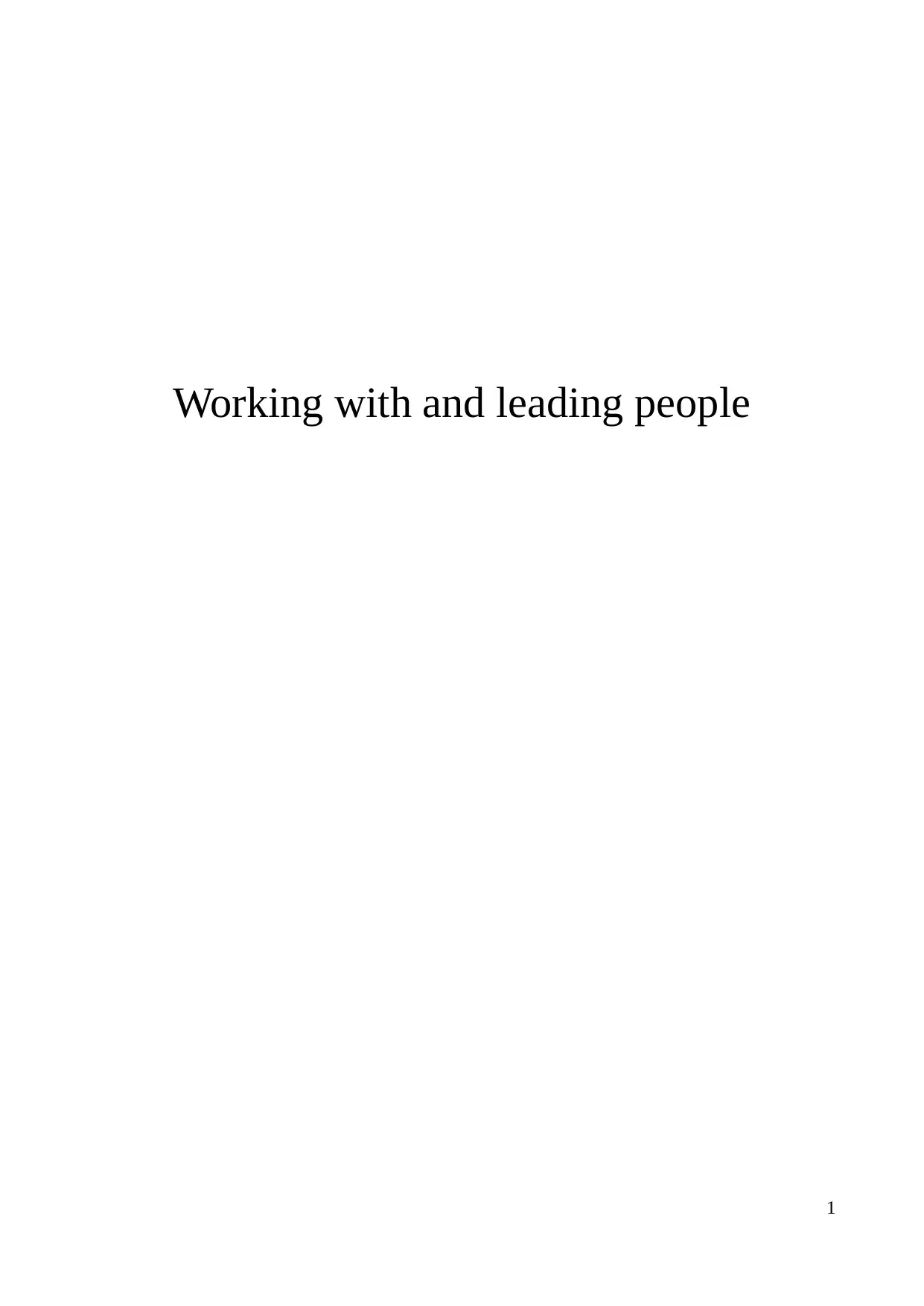
Working with and leading people
1
1
Secure Best Marks with AI Grader
Need help grading? Try our AI Grader for instant feedback on your assignments.
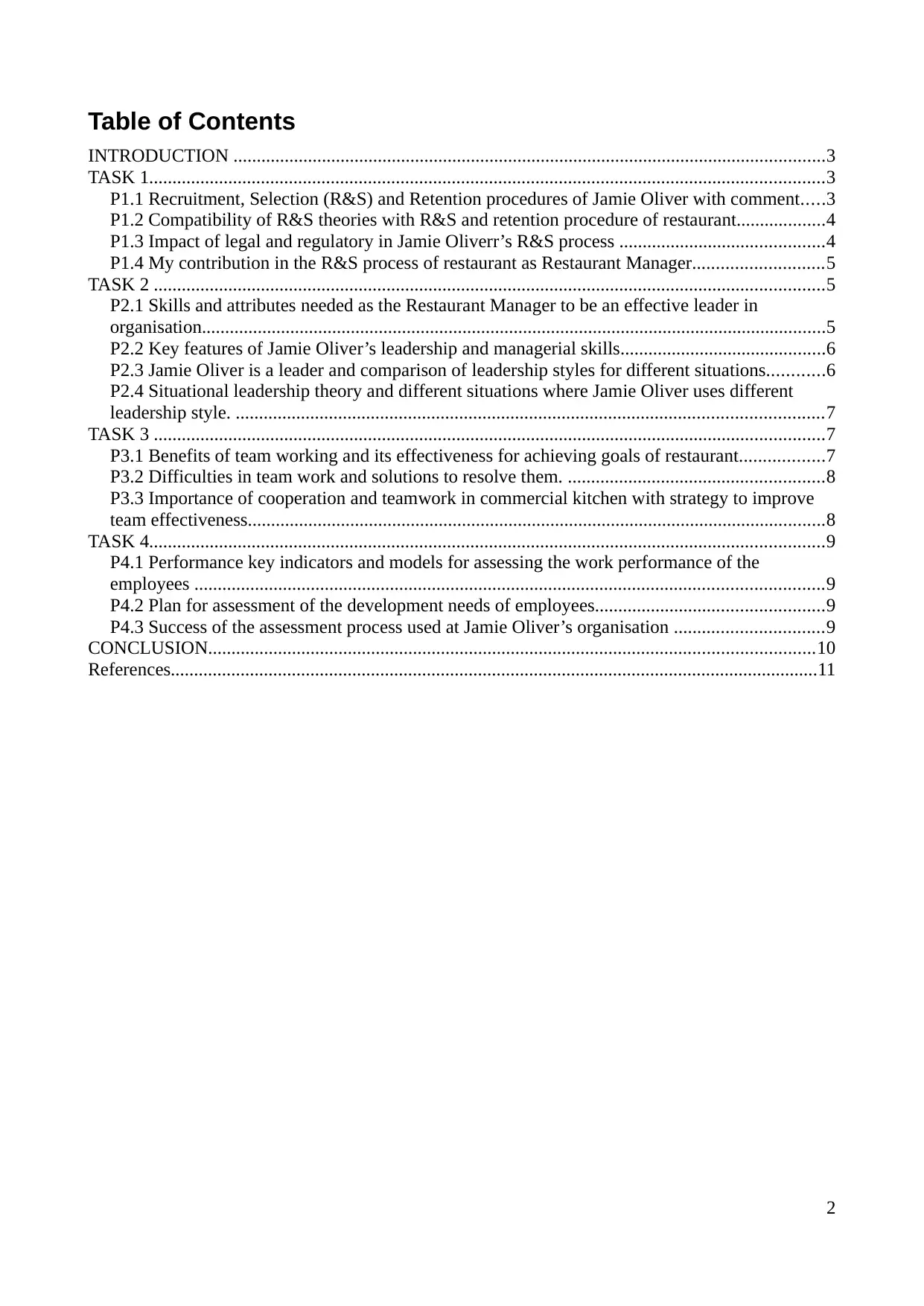
Table of Contents
INTRODUCTION ...............................................................................................................................3
TASK 1.................................................................................................................................................3
P1.1 Recruitment, Selection (R&S) and Retention procedures of Jamie Oliver with comment.....3
P1.2 Compatibility of R&S theories with R&S and retention procedure of restaurant...................4
P1.3 Impact of legal and regulatory in Jamie Oliverr’s R&S process ............................................4
P1.4 My contribution in the R&S process of restaurant as Restaurant Manager............................5
TASK 2 ................................................................................................................................................5
P2.1 Skills and attributes needed as the Restaurant Manager to be an effective leader in
organisation......................................................................................................................................5
P2.2 Key features of Jamie Oliver’s leadership and managerial skills............................................6
P2.3 Jamie Oliver is a leader and comparison of leadership styles for different situations............6
P2.4 Situational leadership theory and different situations where Jamie Oliver uses different
leadership style. ..............................................................................................................................7
TASK 3 ................................................................................................................................................7
P3.1 Benefits of team working and its effectiveness for achieving goals of restaurant..................7
P3.2 Difficulties in team work and solutions to resolve them. .......................................................8
P3.3 Importance of cooperation and teamwork in commercial kitchen with strategy to improve
team effectiveness............................................................................................................................8
TASK 4.................................................................................................................................................9
P4.1 Performance key indicators and models for assessing the work performance of the
employees .......................................................................................................................................9
P4.2 Plan for assessment of the development needs of employees.................................................9
P4.3 Success of the assessment process used at Jamie Oliver’s organisation ................................9
CONCLUSION..................................................................................................................................10
References...........................................................................................................................................11
2
INTRODUCTION ...............................................................................................................................3
TASK 1.................................................................................................................................................3
P1.1 Recruitment, Selection (R&S) and Retention procedures of Jamie Oliver with comment.....3
P1.2 Compatibility of R&S theories with R&S and retention procedure of restaurant...................4
P1.3 Impact of legal and regulatory in Jamie Oliverr’s R&S process ............................................4
P1.4 My contribution in the R&S process of restaurant as Restaurant Manager............................5
TASK 2 ................................................................................................................................................5
P2.1 Skills and attributes needed as the Restaurant Manager to be an effective leader in
organisation......................................................................................................................................5
P2.2 Key features of Jamie Oliver’s leadership and managerial skills............................................6
P2.3 Jamie Oliver is a leader and comparison of leadership styles for different situations............6
P2.4 Situational leadership theory and different situations where Jamie Oliver uses different
leadership style. ..............................................................................................................................7
TASK 3 ................................................................................................................................................7
P3.1 Benefits of team working and its effectiveness for achieving goals of restaurant..................7
P3.2 Difficulties in team work and solutions to resolve them. .......................................................8
P3.3 Importance of cooperation and teamwork in commercial kitchen with strategy to improve
team effectiveness............................................................................................................................8
TASK 4.................................................................................................................................................9
P4.1 Performance key indicators and models for assessing the work performance of the
employees .......................................................................................................................................9
P4.2 Plan for assessment of the development needs of employees.................................................9
P4.3 Success of the assessment process used at Jamie Oliver’s organisation ................................9
CONCLUSION..................................................................................................................................10
References...........................................................................................................................................11
2
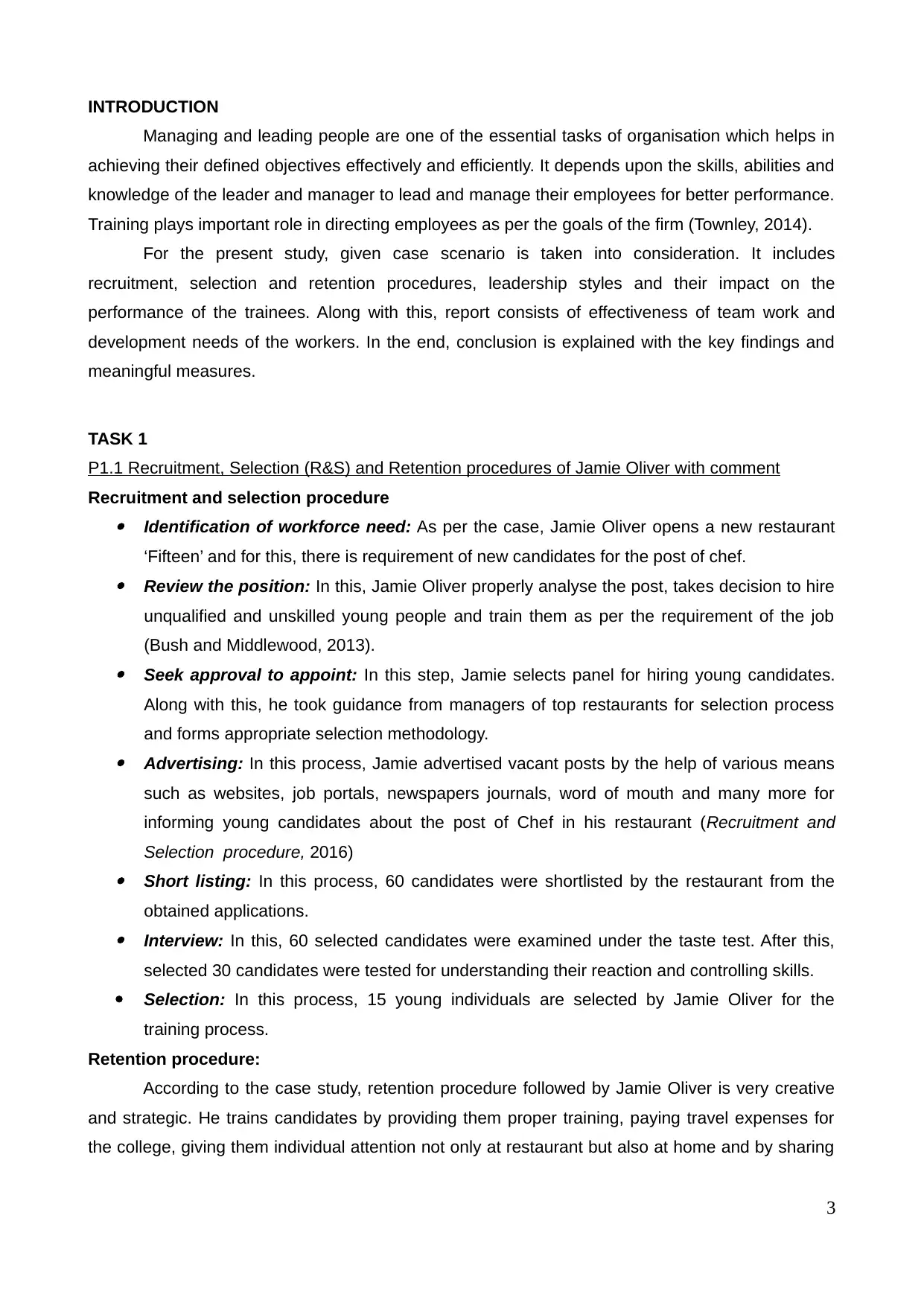
INTRODUCTION
Managing and leading people are one of the essential tasks of organisation which helps in
achieving their defined objectives effectively and efficiently. It depends upon the skills, abilities and
knowledge of the leader and manager to lead and manage their employees for better performance.
Training plays important role in directing employees as per the goals of the firm (Townley, 2014).
For the present study, given case scenario is taken into consideration. It includes
recruitment, selection and retention procedures, leadership styles and their impact on the
performance of the trainees. Along with this, report consists of effectiveness of team work and
development needs of the workers. In the end, conclusion is explained with the key findings and
meaningful measures.
TASK 1
P1.1 Recruitment, Selection (R&S) and Retention procedures of Jamie Oliver with comment
Recruitment and selection procedure Identification of workforce need: As per the case, Jamie Oliver opens a new restaurant
‘Fifteen’ and for this, there is requirement of new candidates for the post of chef. Review the position: In this, Jamie Oliver properly analyse the post, takes decision to hire
unqualified and unskilled young people and train them as per the requirement of the job
(Bush and Middlewood, 2013). Seek approval to appoint: In this step, Jamie selects panel for hiring young candidates.
Along with this, he took guidance from managers of top restaurants for selection process
and forms appropriate selection methodology. Advertising: In this process, Jamie advertised vacant posts by the help of various means
such as websites, job portals, newspapers journals, word of mouth and many more for
informing young candidates about the post of Chef in his restaurant (Recruitment and
Selection procedure, 2016) Short listing: In this process, 60 candidates were shortlisted by the restaurant from the
obtained applications. Interview: In this, 60 selected candidates were examined under the taste test. After this,
selected 30 candidates were tested for understanding their reaction and controlling skills.
Selection: In this process, 15 young individuals are selected by Jamie Oliver for the
training process.
Retention procedure:
According to the case study, retention procedure followed by Jamie Oliver is very creative
and strategic. He trains candidates by providing them proper training, paying travel expenses for
the college, giving them individual attention not only at restaurant but also at home and by sharing
3
Managing and leading people are one of the essential tasks of organisation which helps in
achieving their defined objectives effectively and efficiently. It depends upon the skills, abilities and
knowledge of the leader and manager to lead and manage their employees for better performance.
Training plays important role in directing employees as per the goals of the firm (Townley, 2014).
For the present study, given case scenario is taken into consideration. It includes
recruitment, selection and retention procedures, leadership styles and their impact on the
performance of the trainees. Along with this, report consists of effectiveness of team work and
development needs of the workers. In the end, conclusion is explained with the key findings and
meaningful measures.
TASK 1
P1.1 Recruitment, Selection (R&S) and Retention procedures of Jamie Oliver with comment
Recruitment and selection procedure Identification of workforce need: As per the case, Jamie Oliver opens a new restaurant
‘Fifteen’ and for this, there is requirement of new candidates for the post of chef. Review the position: In this, Jamie Oliver properly analyse the post, takes decision to hire
unqualified and unskilled young people and train them as per the requirement of the job
(Bush and Middlewood, 2013). Seek approval to appoint: In this step, Jamie selects panel for hiring young candidates.
Along with this, he took guidance from managers of top restaurants for selection process
and forms appropriate selection methodology. Advertising: In this process, Jamie advertised vacant posts by the help of various means
such as websites, job portals, newspapers journals, word of mouth and many more for
informing young candidates about the post of Chef in his restaurant (Recruitment and
Selection procedure, 2016) Short listing: In this process, 60 candidates were shortlisted by the restaurant from the
obtained applications. Interview: In this, 60 selected candidates were examined under the taste test. After this,
selected 30 candidates were tested for understanding their reaction and controlling skills.
Selection: In this process, 15 young individuals are selected by Jamie Oliver for the
training process.
Retention procedure:
According to the case study, retention procedure followed by Jamie Oliver is very creative
and strategic. He trains candidates by providing them proper training, paying travel expenses for
the college, giving them individual attention not only at restaurant but also at home and by sharing
3

night shifts in a bakery. All this shows that Jamie Oliver is using appropriate ways for training
candidates properly so that they become a good chef. Techniques used by him are appropriate
which shows that he is a good leader who always keeps himself ready for guiding his trainees
(Ollila and Elmquist, 2011).
P1.2 Compatibility of R&S theories with R&S and retention procedure of restaurant
Theories of recruitment and selection are as follows: Subjective Theory: According to this theory, recruiter assumes that candidates are
irrational but they have social and psychological needs. For this, company highlights job
security, opportunities for promotion, career development, etc. As per this theory, Jamie
Oliver’s recruitment and selection procedure is appropriate as he is hiring unskilled and
unqualified applicants for post of Chef (Kramer, 2007). Along with this, for retention, there
is full emphasis on the growth opportunities of the adults and restaurant is providing various
benefits such as travel expenses, real time training, night shifts, etc to them (Bertoli,
Moraga and Ortega, 2013).
Critical Contact Theory: This theory assumes that quality of recruiter i.e. warmness,
interaction skills, sincerity, follow-up calls, etc plays more important role in hiring a
candidate. It considers that experienced and skilled recruiter is more successful than
inexperienced recruiter. According to this, Jamie Oliver is skilled and knowledgeable
recruiter who possesses quality skills and information in the field of cooking and leadership
management. With the help of his sincere behaviour, patience, proper monitoring and
guiding skills, communication skills, etc, he is able to hold trainees (Kim and Brymer, 2011).
P1.3 Impact of legal and regulatory in Jamie Oliverr’s R&S process
There are some laws and regulations formed by the UK government which are important to
follow in the organization. These laws and regulations are as follows: Employment Protection Act 1978: This act is regarding the contract of employment
which is inclusive of name of parties, title of job, holidays, working hours, etc. It is essential
for the ‘Fifteen’ restaurant to follow this act while selecting young candidates for the post of
Chef. Sex Discrimination Act 1975: As per this act, ‘Fifteen’ restaurant is not allowed to
differentiate between the men and women. They should have equal rights, equal terms and
conditions in selection procedure, training and various employment benefits (Baiden and
Price, 2011).
Disability Discrimination Act 1995: According to this act, disabled person should not be
discriminated while applying for a job and giving an interview by the restaurant. It will also
help in making good image of Fifteen and Jamie Oliver among the candidates and other
people (Galegher, Kraut and Egido, 2014).
4
candidates properly so that they become a good chef. Techniques used by him are appropriate
which shows that he is a good leader who always keeps himself ready for guiding his trainees
(Ollila and Elmquist, 2011).
P1.2 Compatibility of R&S theories with R&S and retention procedure of restaurant
Theories of recruitment and selection are as follows: Subjective Theory: According to this theory, recruiter assumes that candidates are
irrational but they have social and psychological needs. For this, company highlights job
security, opportunities for promotion, career development, etc. As per this theory, Jamie
Oliver’s recruitment and selection procedure is appropriate as he is hiring unskilled and
unqualified applicants for post of Chef (Kramer, 2007). Along with this, for retention, there
is full emphasis on the growth opportunities of the adults and restaurant is providing various
benefits such as travel expenses, real time training, night shifts, etc to them (Bertoli,
Moraga and Ortega, 2013).
Critical Contact Theory: This theory assumes that quality of recruiter i.e. warmness,
interaction skills, sincerity, follow-up calls, etc plays more important role in hiring a
candidate. It considers that experienced and skilled recruiter is more successful than
inexperienced recruiter. According to this, Jamie Oliver is skilled and knowledgeable
recruiter who possesses quality skills and information in the field of cooking and leadership
management. With the help of his sincere behaviour, patience, proper monitoring and
guiding skills, communication skills, etc, he is able to hold trainees (Kim and Brymer, 2011).
P1.3 Impact of legal and regulatory in Jamie Oliverr’s R&S process
There are some laws and regulations formed by the UK government which are important to
follow in the organization. These laws and regulations are as follows: Employment Protection Act 1978: This act is regarding the contract of employment
which is inclusive of name of parties, title of job, holidays, working hours, etc. It is essential
for the ‘Fifteen’ restaurant to follow this act while selecting young candidates for the post of
Chef. Sex Discrimination Act 1975: As per this act, ‘Fifteen’ restaurant is not allowed to
differentiate between the men and women. They should have equal rights, equal terms and
conditions in selection procedure, training and various employment benefits (Baiden and
Price, 2011).
Disability Discrimination Act 1995: According to this act, disabled person should not be
discriminated while applying for a job and giving an interview by the restaurant. It will also
help in making good image of Fifteen and Jamie Oliver among the candidates and other
people (Galegher, Kraut and Egido, 2014).
4
Secure Best Marks with AI Grader
Need help grading? Try our AI Grader for instant feedback on your assignments.

Areas for improvement:
Candidates need to self evaluate themselves for identifying change and improvement in
them.
Fifteen should include personal interview in their selection procedure. It will help in
understanding the individual's perception, views, etc more effectively (Ericsson, Prietula and
Cokely, 2007).
Restaurant should give statement of employment to the candidates with proper details of
their salary, working hours, holiday, etc (West, 2012).
P1.4 My contribution in the R&S process of restaurant as Restaurant Manager
As a Restaurant Manager, my contribution in the recruitment and selection procedure with
Jamie Olive is discussed below: Selection of recruitment and selection panel: Jamie Oliver selects members for the
recruitment and selection process including me. I attend number of meetings with the panel
for planning the procedure appropriately. Along with this, I help in applying critical contact
theory for the recruitment procedure. Short listing: In this process, I help panel in short listing 60 applicants from the obtained
lots of applications. Along with this, I involved in decision making process with the panel
regarding the selection procedures. As per the theory, I keep my behaviour warmth, proper,
polite and interactive for making the procedure effective. Selection: I help in observing and evaluating the candidates through their selection
procedure and check their basic skills, knowledge and abilities with the other members. I
also prepare documents for the selected candidates with the offer letter. Along with this, I
take care of the all the laws and regulations in the whole recruitment and selection
procedure .
Appointment: I help R&S panel in selecting right young candidates for the training of Chef.
Along with it, I explain the work of appointed for 15 candidates. I also give all the
information to them about the restaurant and the way in which they will be trained by the
restaurant.
TASK 2
P2.1 Skills and attributes needed as the Restaurant Manager to be an effective leader in
organisation.
Skills and attributes required as the Restaurant Manger to be an effective leader are as
follows.
Manager should have effective communication skills for dealing with the team members
properly. In the restaurant it is important to communicate properly with the candidates so
that improvement in them can be identified and issues can be solved properly (Farh, Seo
5
Candidates need to self evaluate themselves for identifying change and improvement in
them.
Fifteen should include personal interview in their selection procedure. It will help in
understanding the individual's perception, views, etc more effectively (Ericsson, Prietula and
Cokely, 2007).
Restaurant should give statement of employment to the candidates with proper details of
their salary, working hours, holiday, etc (West, 2012).
P1.4 My contribution in the R&S process of restaurant as Restaurant Manager
As a Restaurant Manager, my contribution in the recruitment and selection procedure with
Jamie Olive is discussed below: Selection of recruitment and selection panel: Jamie Oliver selects members for the
recruitment and selection process including me. I attend number of meetings with the panel
for planning the procedure appropriately. Along with this, I help in applying critical contact
theory for the recruitment procedure. Short listing: In this process, I help panel in short listing 60 applicants from the obtained
lots of applications. Along with this, I involved in decision making process with the panel
regarding the selection procedures. As per the theory, I keep my behaviour warmth, proper,
polite and interactive for making the procedure effective. Selection: I help in observing and evaluating the candidates through their selection
procedure and check their basic skills, knowledge and abilities with the other members. I
also prepare documents for the selected candidates with the offer letter. Along with this, I
take care of the all the laws and regulations in the whole recruitment and selection
procedure .
Appointment: I help R&S panel in selecting right young candidates for the training of Chef.
Along with it, I explain the work of appointed for 15 candidates. I also give all the
information to them about the restaurant and the way in which they will be trained by the
restaurant.
TASK 2
P2.1 Skills and attributes needed as the Restaurant Manager to be an effective leader in
organisation.
Skills and attributes required as the Restaurant Manger to be an effective leader are as
follows.
Manager should have effective communication skills for dealing with the team members
properly. In the restaurant it is important to communicate properly with the candidates so
that improvement in them can be identified and issues can be solved properly (Farh, Seo
5

and Tesluk, 2012).
Delegation is another skill required in a manager for becoming a effective leader. As leader
knows how to share the work among the team members with the help of delegation. With
the help of this skill, manager will able to provide right post to the right trainee (Wagner,
2007).
Restaurant Manager needs to have negotiation skills for achieving the desired results with
the cooperation and coordination of the team. Negotiation helps him in decision making
process and solving the problems. This will make manager to solve the problems and
issues of the trainees which will help them in betterment (Root III, 2016).
Influential leaders help in inspiring team members to work effectively and efficiently to
achieve the organisation's objectives. With the help of this skill, Restaurant manager can
help Jamie Oliver in guiding and monitoring trainees and other team members properly
(Robinson, 2010).
P2.2 Key features of Jamie Oliver’s leadership and managerial skills
Key features of Jamie Oliver's leadership and management skills are as follows. Trait Theory of leadership: According to this, a leader goes through a variety of conditions
and to face those situations or task it is essential to have leadership traits such as
intelligence, adjustment, openness, experience, self efficiency, etc (McKee and Guthridge,
2006). As per this theory, Jamie Oliver posses traits of experience, openness, talent, proper
knowledge, seriousness, extroversion, etc which helps in guiding trainees in more effective
manner and to solve their problems with appropriate solution (Du and et.al., 2013). Behavioural Theory: This suggests that a leader should have positive attitude, strong
personality and self confidence. Oliver posses a very positive attitude which influences his
candidates to perform well and to achieve the goal. Due to the strict discipline he
suspended two students because of their aggressive and violent behaviour. This shows that
Jamie is very serious, disciplined and strict leader (Bush and Middlewood, 2013).
Human Relation Theory: This a management theory and according to it, focus of a
manager is on motivation, relationship maintenance and leadership skills. As per this
theory, Jamie Oliver maintain a good relation with his trainees and employees of the
restaurant for achieving the objectives (Wheeler and Edlebeck, 2006). He also motivates
them time to time for bringing improvement in the performance and for this, he guides,
communicates, interacts, monitors, etc them (McNamara, 2016).
P2.3 Jamie Oliver is a leader and comparison of leadership styles for different situations.
Jamie Oliver is a leader rather than a manager as he guides and monitors his students and
employees properly for achieving restaurant's objective. Jamie works hard with the trainees as he
spent night shift with them in a bakery for helping and guiding them. Along with this, he always
6
Delegation is another skill required in a manager for becoming a effective leader. As leader
knows how to share the work among the team members with the help of delegation. With
the help of this skill, manager will able to provide right post to the right trainee (Wagner,
2007).
Restaurant Manager needs to have negotiation skills for achieving the desired results with
the cooperation and coordination of the team. Negotiation helps him in decision making
process and solving the problems. This will make manager to solve the problems and
issues of the trainees which will help them in betterment (Root III, 2016).
Influential leaders help in inspiring team members to work effectively and efficiently to
achieve the organisation's objectives. With the help of this skill, Restaurant manager can
help Jamie Oliver in guiding and monitoring trainees and other team members properly
(Robinson, 2010).
P2.2 Key features of Jamie Oliver’s leadership and managerial skills
Key features of Jamie Oliver's leadership and management skills are as follows. Trait Theory of leadership: According to this, a leader goes through a variety of conditions
and to face those situations or task it is essential to have leadership traits such as
intelligence, adjustment, openness, experience, self efficiency, etc (McKee and Guthridge,
2006). As per this theory, Jamie Oliver posses traits of experience, openness, talent, proper
knowledge, seriousness, extroversion, etc which helps in guiding trainees in more effective
manner and to solve their problems with appropriate solution (Du and et.al., 2013). Behavioural Theory: This suggests that a leader should have positive attitude, strong
personality and self confidence. Oliver posses a very positive attitude which influences his
candidates to perform well and to achieve the goal. Due to the strict discipline he
suspended two students because of their aggressive and violent behaviour. This shows that
Jamie is very serious, disciplined and strict leader (Bush and Middlewood, 2013).
Human Relation Theory: This a management theory and according to it, focus of a
manager is on motivation, relationship maintenance and leadership skills. As per this
theory, Jamie Oliver maintain a good relation with his trainees and employees of the
restaurant for achieving the objectives (Wheeler and Edlebeck, 2006). He also motivates
them time to time for bringing improvement in the performance and for this, he guides,
communicates, interacts, monitors, etc them (McNamara, 2016).
P2.3 Jamie Oliver is a leader and comparison of leadership styles for different situations.
Jamie Oliver is a leader rather than a manager as he guides and monitors his students and
employees properly for achieving restaurant's objective. Jamie works hard with the trainees as he
spent night shift with them in a bakery for helping and guiding them. Along with this, he always
6
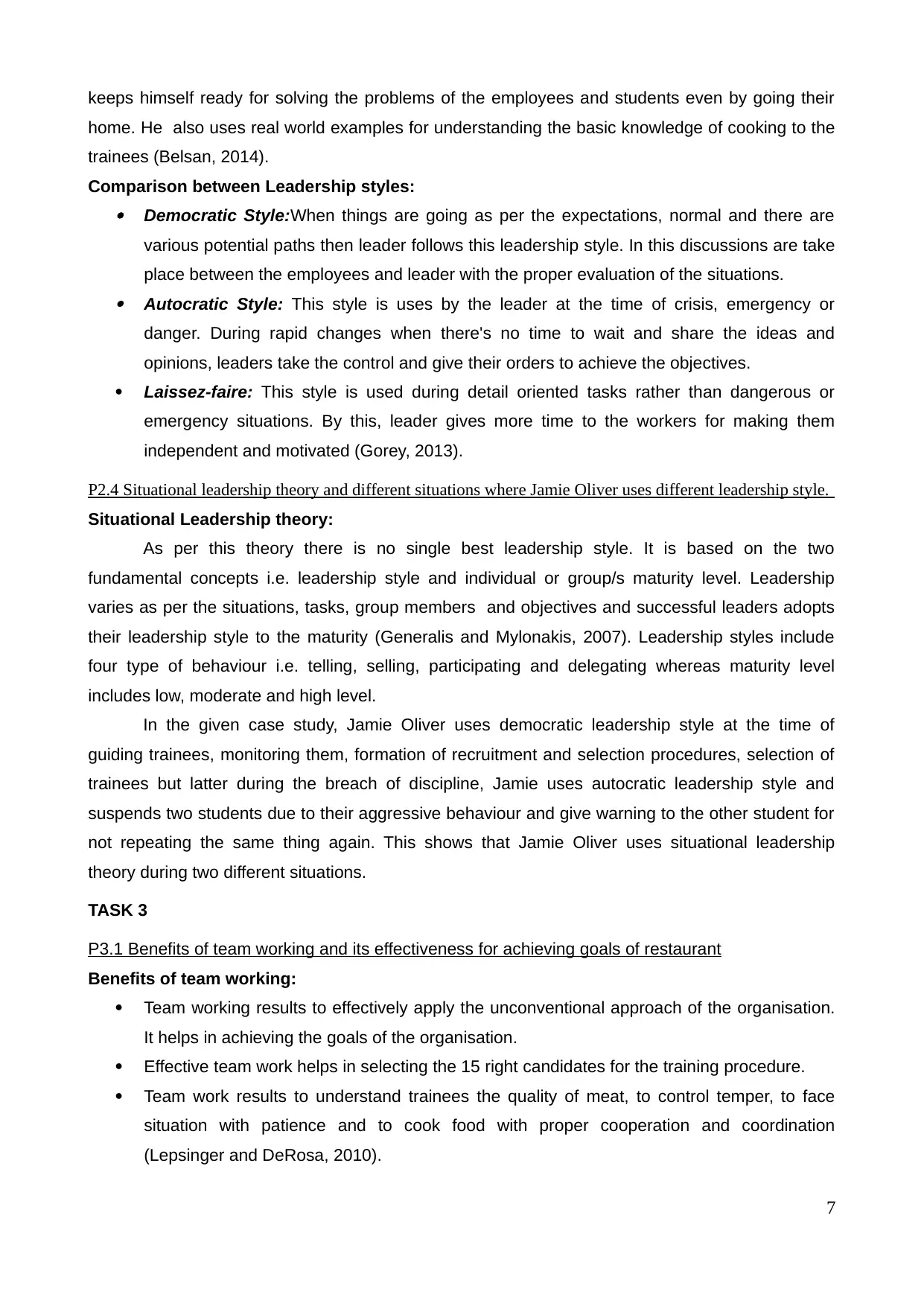
keeps himself ready for solving the problems of the employees and students even by going their
home. He also uses real world examples for understanding the basic knowledge of cooking to the
trainees (Belsan, 2014).
Comparison between Leadership styles: Democratic Style:When things are going as per the expectations, normal and there are
various potential paths then leader follows this leadership style. In this discussions are take
place between the employees and leader with the proper evaluation of the situations. Autocratic Style: This style is uses by the leader at the time of crisis, emergency or
danger. During rapid changes when there's no time to wait and share the ideas and
opinions, leaders take the control and give their orders to achieve the objectives.
Laissez-faire: This style is used during detail oriented tasks rather than dangerous or
emergency situations. By this, leader gives more time to the workers for making them
independent and motivated (Gorey, 2013).
P2.4 Situational leadership theory and different situations where Jamie Oliver uses different leadership style.
Situational Leadership theory:
As per this theory there is no single best leadership style. It is based on the two
fundamental concepts i.e. leadership style and individual or group/s maturity level. Leadership
varies as per the situations, tasks, group members and objectives and successful leaders adopts
their leadership style to the maturity (Generalis and Mylonakis, 2007). Leadership styles include
four type of behaviour i.e. telling, selling, participating and delegating whereas maturity level
includes low, moderate and high level.
In the given case study, Jamie Oliver uses democratic leadership style at the time of
guiding trainees, monitoring them, formation of recruitment and selection procedures, selection of
trainees but latter during the breach of discipline, Jamie uses autocratic leadership style and
suspends two students due to their aggressive behaviour and give warning to the other student for
not repeating the same thing again. This shows that Jamie Oliver uses situational leadership
theory during two different situations.
TASK 3
P3.1 Benefits of team working and its effectiveness for achieving goals of restaurant
Benefits of team working:
Team working results to effectively apply the unconventional approach of the organisation.
It helps in achieving the goals of the organisation.
Effective team work helps in selecting the 15 right candidates for the training procedure.
Team work results to understand trainees the quality of meat, to control temper, to face
situation with patience and to cook food with proper cooperation and coordination
(Lepsinger and DeRosa, 2010).
7
home. He also uses real world examples for understanding the basic knowledge of cooking to the
trainees (Belsan, 2014).
Comparison between Leadership styles: Democratic Style:When things are going as per the expectations, normal and there are
various potential paths then leader follows this leadership style. In this discussions are take
place between the employees and leader with the proper evaluation of the situations. Autocratic Style: This style is uses by the leader at the time of crisis, emergency or
danger. During rapid changes when there's no time to wait and share the ideas and
opinions, leaders take the control and give their orders to achieve the objectives.
Laissez-faire: This style is used during detail oriented tasks rather than dangerous or
emergency situations. By this, leader gives more time to the workers for making them
independent and motivated (Gorey, 2013).
P2.4 Situational leadership theory and different situations where Jamie Oliver uses different leadership style.
Situational Leadership theory:
As per this theory there is no single best leadership style. It is based on the two
fundamental concepts i.e. leadership style and individual or group/s maturity level. Leadership
varies as per the situations, tasks, group members and objectives and successful leaders adopts
their leadership style to the maturity (Generalis and Mylonakis, 2007). Leadership styles include
four type of behaviour i.e. telling, selling, participating and delegating whereas maturity level
includes low, moderate and high level.
In the given case study, Jamie Oliver uses democratic leadership style at the time of
guiding trainees, monitoring them, formation of recruitment and selection procedures, selection of
trainees but latter during the breach of discipline, Jamie uses autocratic leadership style and
suspends two students due to their aggressive behaviour and give warning to the other student for
not repeating the same thing again. This shows that Jamie Oliver uses situational leadership
theory during two different situations.
TASK 3
P3.1 Benefits of team working and its effectiveness for achieving goals of restaurant
Benefits of team working:
Team working results to effectively apply the unconventional approach of the organisation.
It helps in achieving the goals of the organisation.
Effective team work helps in selecting the 15 right candidates for the training procedure.
Team work results to understand trainees the quality of meat, to control temper, to face
situation with patience and to cook food with proper cooperation and coordination
(Lepsinger and DeRosa, 2010).
7
Paraphrase This Document
Need a fresh take? Get an instant paraphrase of this document with our AI Paraphraser
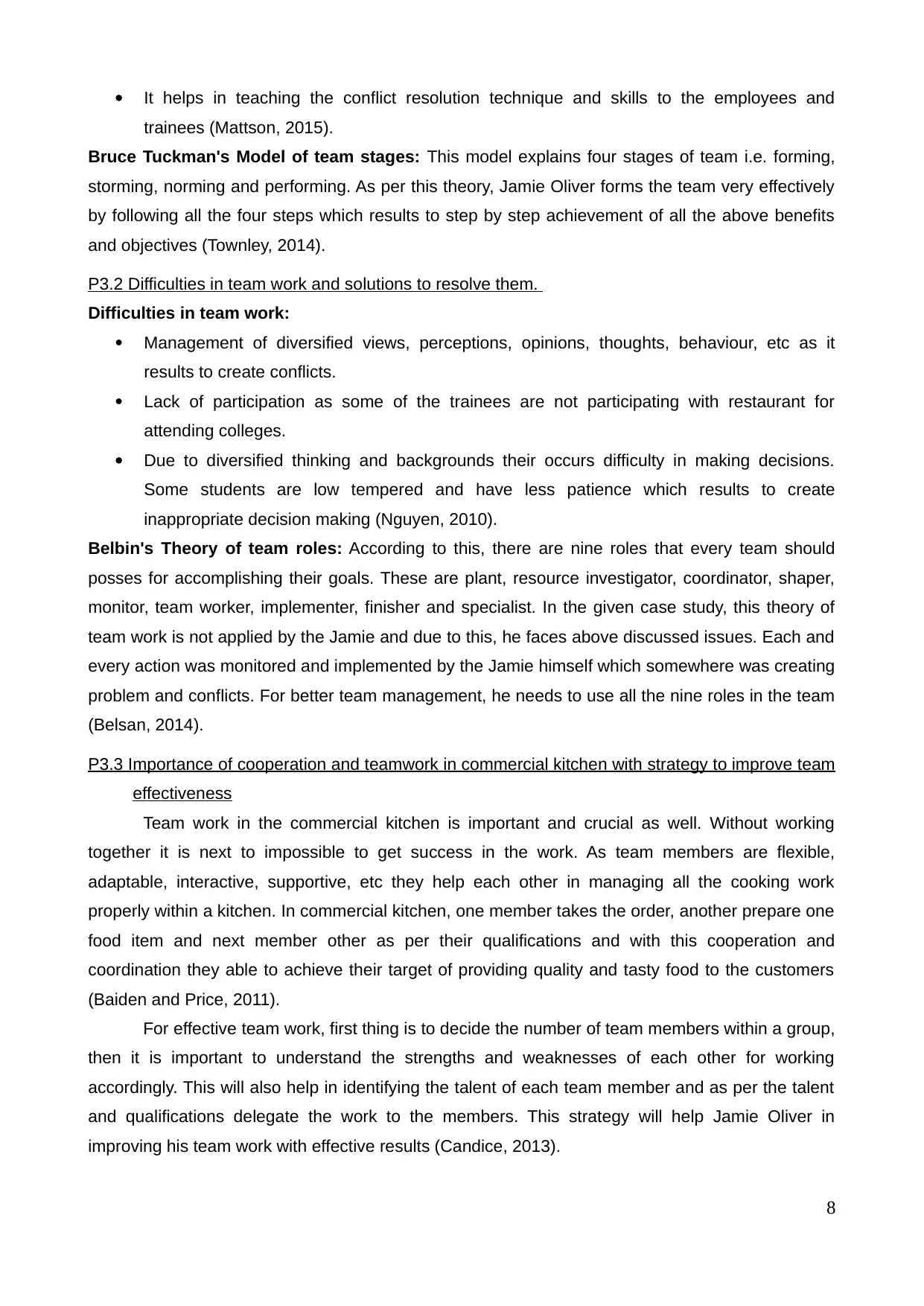
It helps in teaching the conflict resolution technique and skills to the employees and
trainees (Mattson, 2015).
Bruce Tuckman's Model of team stages: This model explains four stages of team i.e. forming,
storming, norming and performing. As per this theory, Jamie Oliver forms the team very effectively
by following all the four steps which results to step by step achievement of all the above benefits
and objectives (Townley, 2014).
P3.2 Difficulties in team work and solutions to resolve them.
Difficulties in team work:
Management of diversified views, perceptions, opinions, thoughts, behaviour, etc as it
results to create conflicts.
Lack of participation as some of the trainees are not participating with restaurant for
attending colleges.
Due to diversified thinking and backgrounds their occurs difficulty in making decisions.
Some students are low tempered and have less patience which results to create
inappropriate decision making (Nguyen, 2010).
Belbin's Theory of team roles: According to this, there are nine roles that every team should
posses for accomplishing their goals. These are plant, resource investigator, coordinator, shaper,
monitor, team worker, implementer, finisher and specialist. In the given case study, this theory of
team work is not applied by the Jamie and due to this, he faces above discussed issues. Each and
every action was monitored and implemented by the Jamie himself which somewhere was creating
problem and conflicts. For better team management, he needs to use all the nine roles in the team
(Belsan, 2014).
P3.3 Importance of cooperation and teamwork in commercial kitchen with strategy to improve team
effectiveness
Team work in the commercial kitchen is important and crucial as well. Without working
together it is next to impossible to get success in the work. As team members are flexible,
adaptable, interactive, supportive, etc they help each other in managing all the cooking work
properly within a kitchen. In commercial kitchen, one member takes the order, another prepare one
food item and next member other as per their qualifications and with this cooperation and
coordination they able to achieve their target of providing quality and tasty food to the customers
(Baiden and Price, 2011).
For effective team work, first thing is to decide the number of team members within a group,
then it is important to understand the strengths and weaknesses of each other for working
accordingly. This will also help in identifying the talent of each team member and as per the talent
and qualifications delegate the work to the members. This strategy will help Jamie Oliver in
improving his team work with effective results (Candice, 2013).
8
trainees (Mattson, 2015).
Bruce Tuckman's Model of team stages: This model explains four stages of team i.e. forming,
storming, norming and performing. As per this theory, Jamie Oliver forms the team very effectively
by following all the four steps which results to step by step achievement of all the above benefits
and objectives (Townley, 2014).
P3.2 Difficulties in team work and solutions to resolve them.
Difficulties in team work:
Management of diversified views, perceptions, opinions, thoughts, behaviour, etc as it
results to create conflicts.
Lack of participation as some of the trainees are not participating with restaurant for
attending colleges.
Due to diversified thinking and backgrounds their occurs difficulty in making decisions.
Some students are low tempered and have less patience which results to create
inappropriate decision making (Nguyen, 2010).
Belbin's Theory of team roles: According to this, there are nine roles that every team should
posses for accomplishing their goals. These are plant, resource investigator, coordinator, shaper,
monitor, team worker, implementer, finisher and specialist. In the given case study, this theory of
team work is not applied by the Jamie and due to this, he faces above discussed issues. Each and
every action was monitored and implemented by the Jamie himself which somewhere was creating
problem and conflicts. For better team management, he needs to use all the nine roles in the team
(Belsan, 2014).
P3.3 Importance of cooperation and teamwork in commercial kitchen with strategy to improve team
effectiveness
Team work in the commercial kitchen is important and crucial as well. Without working
together it is next to impossible to get success in the work. As team members are flexible,
adaptable, interactive, supportive, etc they help each other in managing all the cooking work
properly within a kitchen. In commercial kitchen, one member takes the order, another prepare one
food item and next member other as per their qualifications and with this cooperation and
coordination they able to achieve their target of providing quality and tasty food to the customers
(Baiden and Price, 2011).
For effective team work, first thing is to decide the number of team members within a group,
then it is important to understand the strengths and weaknesses of each other for working
accordingly. This will also help in identifying the talent of each team member and as per the talent
and qualifications delegate the work to the members. This strategy will help Jamie Oliver in
improving his team work with effective results (Candice, 2013).
8
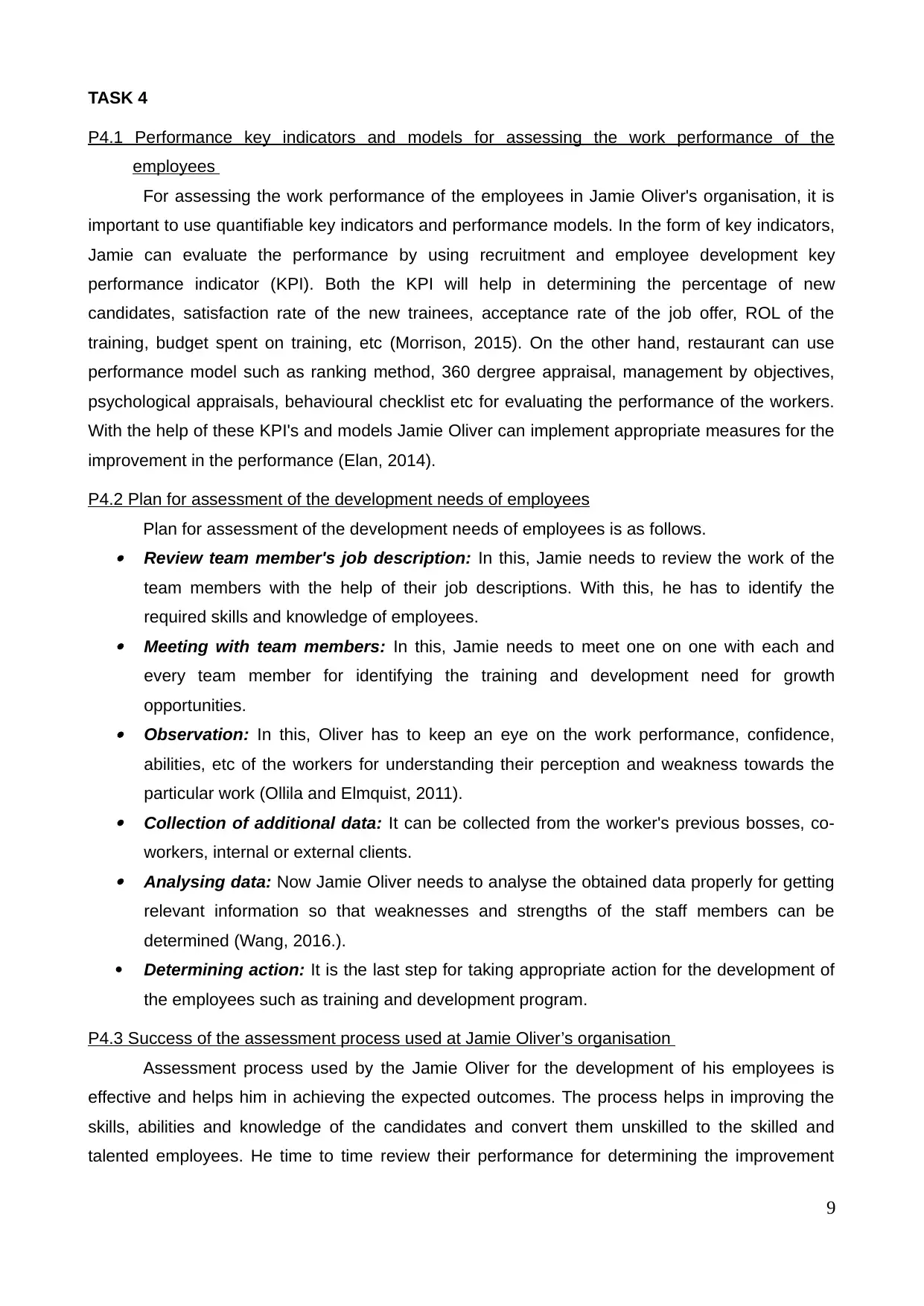
TASK 4
P4.1 Performance key indicators and models for assessing the work performance of the
employees
For assessing the work performance of the employees in Jamie Oliver's organisation, it is
important to use quantifiable key indicators and performance models. In the form of key indicators,
Jamie can evaluate the performance by using recruitment and employee development key
performance indicator (KPI). Both the KPI will help in determining the percentage of new
candidates, satisfaction rate of the new trainees, acceptance rate of the job offer, ROL of the
training, budget spent on training, etc (Morrison, 2015). On the other hand, restaurant can use
performance model such as ranking method, 360 dergree appraisal, management by objectives,
psychological appraisals, behavioural checklist etc for evaluating the performance of the workers.
With the help of these KPI's and models Jamie Oliver can implement appropriate measures for the
improvement in the performance (Elan, 2014).
P4.2 Plan for assessment of the development needs of employees
Plan for assessment of the development needs of employees is as follows. Review team member's job description: In this, Jamie needs to review the work of the
team members with the help of their job descriptions. With this, he has to identify the
required skills and knowledge of employees. Meeting with team members: In this, Jamie needs to meet one on one with each and
every team member for identifying the training and development need for growth
opportunities. Observation: In this, Oliver has to keep an eye on the work performance, confidence,
abilities, etc of the workers for understanding their perception and weakness towards the
particular work (Ollila and Elmquist, 2011). Collection of additional data: It can be collected from the worker's previous bosses, co-
workers, internal or external clients. Analysing data: Now Jamie Oliver needs to analyse the obtained data properly for getting
relevant information so that weaknesses and strengths of the staff members can be
determined (Wang, 2016.).
Determining action: It is the last step for taking appropriate action for the development of
the employees such as training and development program.
P4.3 Success of the assessment process used at Jamie Oliver’s organisation
Assessment process used by the Jamie Oliver for the development of his employees is
effective and helps him in achieving the expected outcomes. The process helps in improving the
skills, abilities and knowledge of the candidates and convert them unskilled to the skilled and
talented employees. He time to time review their performance for determining the improvement
9
P4.1 Performance key indicators and models for assessing the work performance of the
employees
For assessing the work performance of the employees in Jamie Oliver's organisation, it is
important to use quantifiable key indicators and performance models. In the form of key indicators,
Jamie can evaluate the performance by using recruitment and employee development key
performance indicator (KPI). Both the KPI will help in determining the percentage of new
candidates, satisfaction rate of the new trainees, acceptance rate of the job offer, ROL of the
training, budget spent on training, etc (Morrison, 2015). On the other hand, restaurant can use
performance model such as ranking method, 360 dergree appraisal, management by objectives,
psychological appraisals, behavioural checklist etc for evaluating the performance of the workers.
With the help of these KPI's and models Jamie Oliver can implement appropriate measures for the
improvement in the performance (Elan, 2014).
P4.2 Plan for assessment of the development needs of employees
Plan for assessment of the development needs of employees is as follows. Review team member's job description: In this, Jamie needs to review the work of the
team members with the help of their job descriptions. With this, he has to identify the
required skills and knowledge of employees. Meeting with team members: In this, Jamie needs to meet one on one with each and
every team member for identifying the training and development need for growth
opportunities. Observation: In this, Oliver has to keep an eye on the work performance, confidence,
abilities, etc of the workers for understanding their perception and weakness towards the
particular work (Ollila and Elmquist, 2011). Collection of additional data: It can be collected from the worker's previous bosses, co-
workers, internal or external clients. Analysing data: Now Jamie Oliver needs to analyse the obtained data properly for getting
relevant information so that weaknesses and strengths of the staff members can be
determined (Wang, 2016.).
Determining action: It is the last step for taking appropriate action for the development of
the employees such as training and development program.
P4.3 Success of the assessment process used at Jamie Oliver’s organisation
Assessment process used by the Jamie Oliver for the development of his employees is
effective and helps him in achieving the expected outcomes. The process helps in improving the
skills, abilities and knowledge of the candidates and convert them unskilled to the skilled and
talented employees. He time to time review their performance for determining the improvement
9
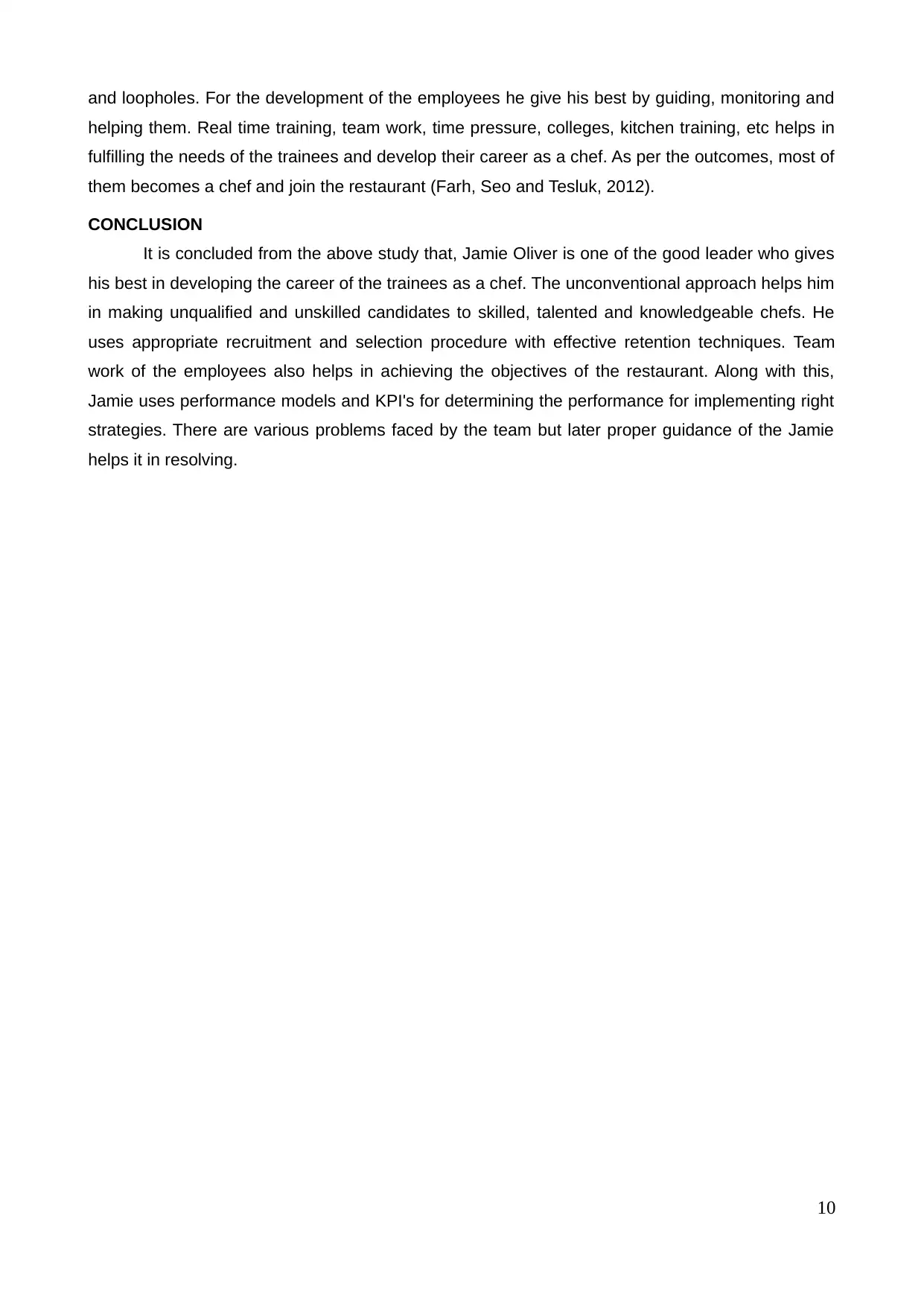
and loopholes. For the development of the employees he give his best by guiding, monitoring and
helping them. Real time training, team work, time pressure, colleges, kitchen training, etc helps in
fulfilling the needs of the trainees and develop their career as a chef. As per the outcomes, most of
them becomes a chef and join the restaurant (Farh, Seo and Tesluk, 2012).
CONCLUSION
It is concluded from the above study that, Jamie Oliver is one of the good leader who gives
his best in developing the career of the trainees as a chef. The unconventional approach helps him
in making unqualified and unskilled candidates to skilled, talented and knowledgeable chefs. He
uses appropriate recruitment and selection procedure with effective retention techniques. Team
work of the employees also helps in achieving the objectives of the restaurant. Along with this,
Jamie uses performance models and KPI's for determining the performance for implementing right
strategies. There are various problems faced by the team but later proper guidance of the Jamie
helps it in resolving.
10
helping them. Real time training, team work, time pressure, colleges, kitchen training, etc helps in
fulfilling the needs of the trainees and develop their career as a chef. As per the outcomes, most of
them becomes a chef and join the restaurant (Farh, Seo and Tesluk, 2012).
CONCLUSION
It is concluded from the above study that, Jamie Oliver is one of the good leader who gives
his best in developing the career of the trainees as a chef. The unconventional approach helps him
in making unqualified and unskilled candidates to skilled, talented and knowledgeable chefs. He
uses appropriate recruitment and selection procedure with effective retention techniques. Team
work of the employees also helps in achieving the objectives of the restaurant. Along with this,
Jamie uses performance models and KPI's for determining the performance for implementing right
strategies. There are various problems faced by the team but later proper guidance of the Jamie
helps it in resolving.
10
Secure Best Marks with AI Grader
Need help grading? Try our AI Grader for instant feedback on your assignments.
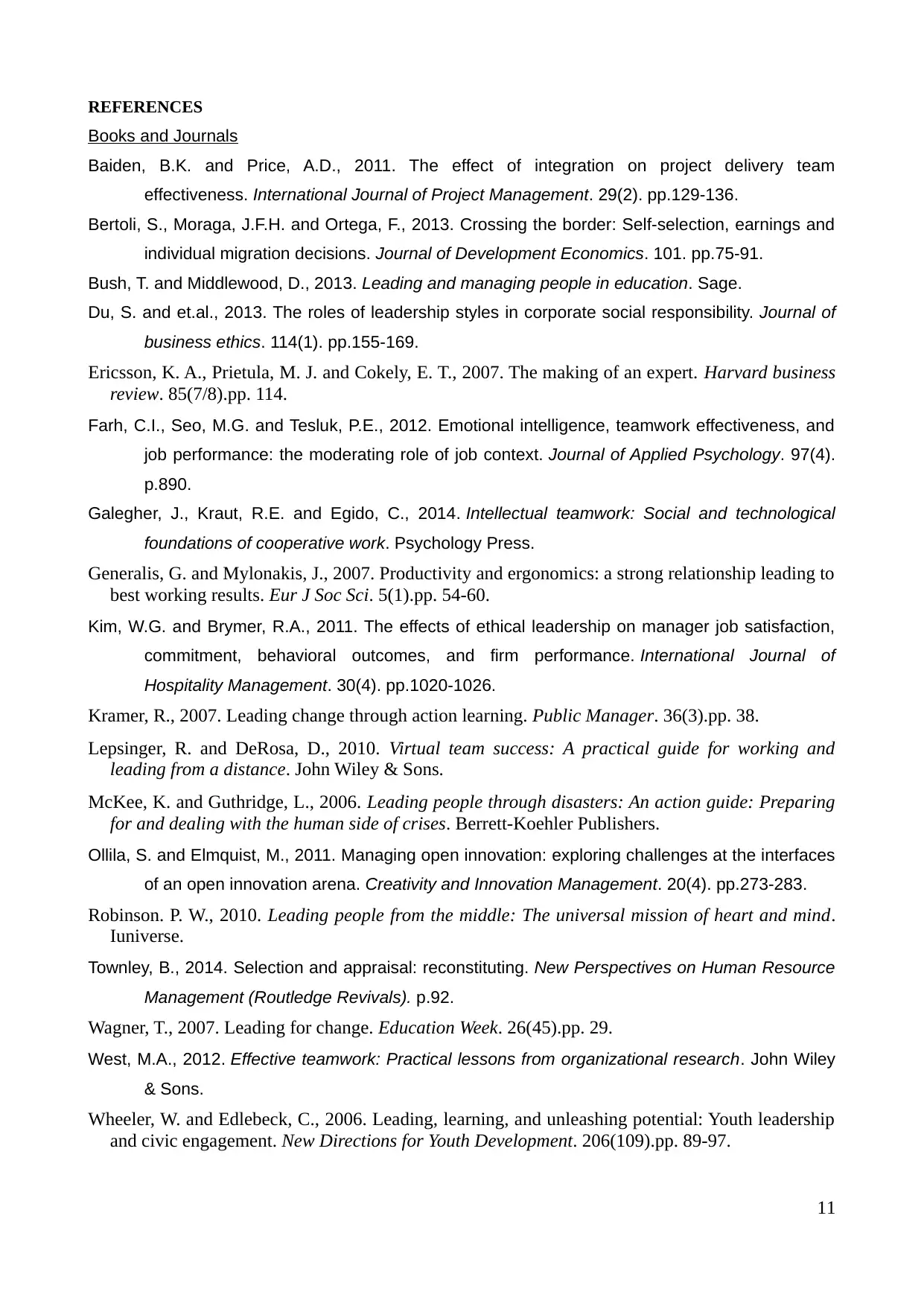
REFERENCES
Books and Journals
Baiden, B.K. and Price, A.D., 2011. The effect of integration on project delivery team
effectiveness. International Journal of Project Management. 29(2). pp.129-136.
Bertoli, S., Moraga, J.F.H. and Ortega, F., 2013. Crossing the border: Self-selection, earnings and
individual migration decisions. Journal of Development Economics. 101. pp.75-91.
Bush, T. and Middlewood, D., 2013. Leading and managing people in education. Sage.
Du, S. and et.al., 2013. The roles of leadership styles in corporate social responsibility. Journal of
business ethics. 114(1). pp.155-169.
Ericsson, K. A., Prietula, M. J. and Cokely, E. T., 2007. The making of an expert. Harvard business
review. 85(7/8).pp. 114.
Farh, C.I., Seo, M.G. and Tesluk, P.E., 2012. Emotional intelligence, teamwork effectiveness, and
job performance: the moderating role of job context. Journal of Applied Psychology. 97(4).
p.890.
Galegher, J., Kraut, R.E. and Egido, C., 2014. Intellectual teamwork: Social and technological
foundations of cooperative work. Psychology Press.
Generalis, G. and Mylonakis, J., 2007. Productivity and ergonomics: a strong relationship leading to
best working results. Eur J Soc Sci. 5(1).pp. 54-60.
Kim, W.G. and Brymer, R.A., 2011. The effects of ethical leadership on manager job satisfaction,
commitment, behavioral outcomes, and firm performance. International Journal of
Hospitality Management. 30(4). pp.1020-1026.
Kramer, R., 2007. Leading change through action learning. Public Manager. 36(3).pp. 38.
Lepsinger, R. and DeRosa, D., 2010. Virtual team success: A practical guide for working and
leading from a distance. John Wiley & Sons.
McKee, K. and Guthridge, L., 2006. Leading people through disasters: An action guide: Preparing
for and dealing with the human side of crises. Berrett-Koehler Publishers.
Ollila, S. and Elmquist, M., 2011. Managing open innovation: exploring challenges at the interfaces
of an open innovation arena. Creativity and Innovation Management. 20(4). pp.273-283.
Robinson. P. W., 2010. Leading people from the middle: The universal mission of heart and mind.
Iuniverse.
Townley, B., 2014. Selection and appraisal: reconstituting. New Perspectives on Human Resource
Management (Routledge Revivals). p.92.
Wagner, T., 2007. Leading for change. Education Week. 26(45).pp. 29.
West, M.A., 2012. Effective teamwork: Practical lessons from organizational research. John Wiley
& Sons.
Wheeler, W. and Edlebeck, C., 2006. Leading, learning, and unleashing potential: Youth leadership
and civic engagement. New Directions for Youth Development. 206(109).pp. 89-97.
11
Books and Journals
Baiden, B.K. and Price, A.D., 2011. The effect of integration on project delivery team
effectiveness. International Journal of Project Management. 29(2). pp.129-136.
Bertoli, S., Moraga, J.F.H. and Ortega, F., 2013. Crossing the border: Self-selection, earnings and
individual migration decisions. Journal of Development Economics. 101. pp.75-91.
Bush, T. and Middlewood, D., 2013. Leading and managing people in education. Sage.
Du, S. and et.al., 2013. The roles of leadership styles in corporate social responsibility. Journal of
business ethics. 114(1). pp.155-169.
Ericsson, K. A., Prietula, M. J. and Cokely, E. T., 2007. The making of an expert. Harvard business
review. 85(7/8).pp. 114.
Farh, C.I., Seo, M.G. and Tesluk, P.E., 2012. Emotional intelligence, teamwork effectiveness, and
job performance: the moderating role of job context. Journal of Applied Psychology. 97(4).
p.890.
Galegher, J., Kraut, R.E. and Egido, C., 2014. Intellectual teamwork: Social and technological
foundations of cooperative work. Psychology Press.
Generalis, G. and Mylonakis, J., 2007. Productivity and ergonomics: a strong relationship leading to
best working results. Eur J Soc Sci. 5(1).pp. 54-60.
Kim, W.G. and Brymer, R.A., 2011. The effects of ethical leadership on manager job satisfaction,
commitment, behavioral outcomes, and firm performance. International Journal of
Hospitality Management. 30(4). pp.1020-1026.
Kramer, R., 2007. Leading change through action learning. Public Manager. 36(3).pp. 38.
Lepsinger, R. and DeRosa, D., 2010. Virtual team success: A practical guide for working and
leading from a distance. John Wiley & Sons.
McKee, K. and Guthridge, L., 2006. Leading people through disasters: An action guide: Preparing
for and dealing with the human side of crises. Berrett-Koehler Publishers.
Ollila, S. and Elmquist, M., 2011. Managing open innovation: exploring challenges at the interfaces
of an open innovation arena. Creativity and Innovation Management. 20(4). pp.273-283.
Robinson. P. W., 2010. Leading people from the middle: The universal mission of heart and mind.
Iuniverse.
Townley, B., 2014. Selection and appraisal: reconstituting. New Perspectives on Human Resource
Management (Routledge Revivals). p.92.
Wagner, T., 2007. Leading for change. Education Week. 26(45).pp. 29.
West, M.A., 2012. Effective teamwork: Practical lessons from organizational research. John Wiley
& Sons.
Wheeler, W. and Edlebeck, C., 2006. Leading, learning, and unleashing potential: Youth leadership
and civic engagement. New Directions for Youth Development. 206(109).pp. 89-97.
11

Online
Belsan, 2014. The thoeries of team building. [Online]. Available Through:
<http://teamworkdefinition.com/theories/>. [Accessed on 22nd February 2016]
Candice, 2013. Teamwork in a commercial kitchen. [Online]. Available Through:
<http://clubtraining.com.au/2013/06/17/teamwork-in-a-commercial-kitchen/>. [Accessed on
22nd February 2016]
Elan, 2014. What are the different types of performance appraisal system. [Online]. Available
Through:<http://www.hrzone.com/community-voice/blogs/elan/what-are-the-
different-types-of-performance-appraisal-system>. [Accessed on 22nd February 2016]
Gorey, A., 2013. Leadership styles for different situations. [Online],. Available Through:
<http://info.profilesinternational.com/profiles-employee-assessment-blog/bid/117287/
Leadership-Styles-For-Different-Situations>. [Accessed on 22nd February 2016]
Mattson, D., 2015. Benefits of teamwork in the workplace. [Online]. Available Through:
<https://www.sandler.com/blog/6-benefits-of-teamwork-in-the-workplace>. [Accessed on
22nd February 2016]
McNamara, C., 2016. Contemporary theories of management. [Online]. Available Through:
<http://managementhelp.org/management/theories.htm>. [Accessed on 22nd February
2016]
Morrison, M., 2015. Key Performance Indicators-Sample KPI's. [Online]. Available
Through:<https://rapidbi.com/samplekeyperformanceindicatorskpi/>. [Accessed on
22nd February 2016]
Nguyen, S., 2010. Eight common problems team encounter. [Online]. Available Through:
<http://workplacepsychology.net/2010/12/17/eight-common-problems-teams-encounter/>.
[Accessed on 22nd February 2016]
Recruitment and Selection procedure. 2016. [Online]. Available Through:
<http://www1.rmit.edu.au/policies/recruitmentandselection>. [Accessed on 22nd February
2016]
Root III, G.N., 2016. The five top qualities needed for an effective leader to facilitate changes in an
organisation. [Online]. Available Through: <http://smallbusiness.chron.com/five-top-
qualities-needed-effective-leader-facilitate-change-organization-5.html>. [Accessed on 22nd
February 2016]
Wang, V. T., 2016. Understanding development needs. [Online]. Available
Through:<https://www.mindtools.com/pages/article/newLDR_06.htm>. [Accessed on
22nd February 2016]
12
Belsan, 2014. The thoeries of team building. [Online]. Available Through:
<http://teamworkdefinition.com/theories/>. [Accessed on 22nd February 2016]
Candice, 2013. Teamwork in a commercial kitchen. [Online]. Available Through:
<http://clubtraining.com.au/2013/06/17/teamwork-in-a-commercial-kitchen/>. [Accessed on
22nd February 2016]
Elan, 2014. What are the different types of performance appraisal system. [Online]. Available
Through:<http://www.hrzone.com/community-voice/blogs/elan/what-are-the-
different-types-of-performance-appraisal-system>. [Accessed on 22nd February 2016]
Gorey, A., 2013. Leadership styles for different situations. [Online],. Available Through:
<http://info.profilesinternational.com/profiles-employee-assessment-blog/bid/117287/
Leadership-Styles-For-Different-Situations>. [Accessed on 22nd February 2016]
Mattson, D., 2015. Benefits of teamwork in the workplace. [Online]. Available Through:
<https://www.sandler.com/blog/6-benefits-of-teamwork-in-the-workplace>. [Accessed on
22nd February 2016]
McNamara, C., 2016. Contemporary theories of management. [Online]. Available Through:
<http://managementhelp.org/management/theories.htm>. [Accessed on 22nd February
2016]
Morrison, M., 2015. Key Performance Indicators-Sample KPI's. [Online]. Available
Through:<https://rapidbi.com/samplekeyperformanceindicatorskpi/>. [Accessed on
22nd February 2016]
Nguyen, S., 2010. Eight common problems team encounter. [Online]. Available Through:
<http://workplacepsychology.net/2010/12/17/eight-common-problems-teams-encounter/>.
[Accessed on 22nd February 2016]
Recruitment and Selection procedure. 2016. [Online]. Available Through:
<http://www1.rmit.edu.au/policies/recruitmentandselection>. [Accessed on 22nd February
2016]
Root III, G.N., 2016. The five top qualities needed for an effective leader to facilitate changes in an
organisation. [Online]. Available Through: <http://smallbusiness.chron.com/five-top-
qualities-needed-effective-leader-facilitate-change-organization-5.html>. [Accessed on 22nd
February 2016]
Wang, V. T., 2016. Understanding development needs. [Online]. Available
Through:<https://www.mindtools.com/pages/article/newLDR_06.htm>. [Accessed on
22nd February 2016]
12
1 out of 12
Related Documents
Your All-in-One AI-Powered Toolkit for Academic Success.
+13062052269
info@desklib.com
Available 24*7 on WhatsApp / Email
![[object Object]](/_next/static/media/star-bottom.7253800d.svg)
Unlock your academic potential
© 2024 | Zucol Services PVT LTD | All rights reserved.





